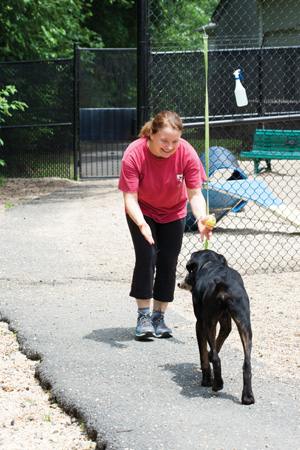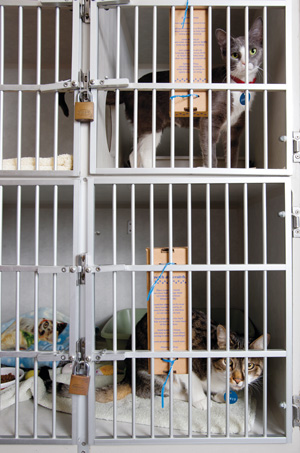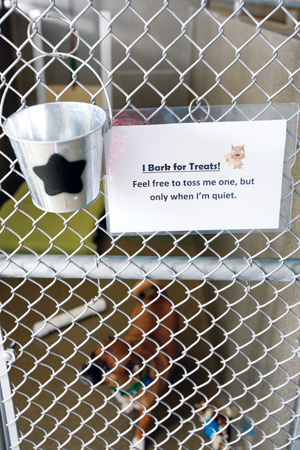Frankie is a three-time loser. He desperately wants to be a family man, but his attempts to form lasting relationships have all failed.
He’s a lovable guy, but sometimes he doesn’t realize his own strength. That’s why the young pit bull terrier has ultimately been rejected by each of his adopted owners. He is too powerful—always wanting to run and play, not realizing how easily he can upend the person holding his leash.
Frankie came to the Animal Welfare League of Arlington (AWLA) as a puppy in March 2011 and was adopted a month later. His first owners kept him almost a year but then reconsidered. In the next eight months, he was back at the shelter three more times.
But maybe today is his lucky day and he’ll be adopted for good. Frankie quivers with excitement as he waits in the shelter’s yard. Honey, a 2½-year-old boxer mix, enters the yard cautiously. Frankie tries to jump on her and she snarls. He backs off, flopping down on his belly, tongue lolling. He stares fixedly at Honey, who is half his size.
“Good correction, Honey! Way to teach him some manners!” says Amy LaFerrera, AWLA’s rescue coordinator. Honey’s owner, K.J. Fisher, looks reassured. She has brought Honey here to see if the two dogs will get along well enough for Frankie to join their family. Right now, the dogs are ignoring one another but lying close. As first dates go, this has been a success.
“You’re just a big, dumb idiot,” LaFerrera says affectionately to Frankie. “You just don’t know you’re 70 pounds, do you?” She suggests that Fisher and her fiance, Ian Hamos, take the two dogs for a walk.
In a country with 78 million pet dogs and 86 million pet cats, it is inevitable that some animals won’t find a good home. In Arlington County, roughly 2,500 homeless animals are taken in by AWLA each year. At any given time, the facility—just down the road from Shirlington Village on Arlington Mill Road—has a capacity of 76 cats and 28 dogs. It also shelters a handful of small animals, such as the turtles, hamsters, guinea pigs and rabbits that are here this summer Saturday.
Parents often bring in the smaller animals when their kids develop allergies or lose interest in taking care of them, LaFerrera says. Robert and Ralph, a pair of New Zealand-mix rabbits, have been here a while. They were probably an Easter gift, but the landlord didn’t allow rabbits.
The shelter won’t turn away any Arlington County animal for space reasons, nor does it euthanize for space reasons. If the facility is full, staffers will work with neighboring counties to shelter the animals; or they will ask one of AWLA’s 600 volunteers to foster a pet.

Fostering is a good alternative for volunteers who want to be with animals but can’t adopt, Arlington resident Ken Shirakawa explains as he greets visitors at the front desk. At his feet, with ears and tail down, is Bailey, an 8-year-old black German shepherd mix who arrived here when his owner decided he couldn’t keep his two dogs. The other dog, who was older, was sick and had to be euthanized. Without his home or his buddy, Bailey now clings to Shirakawa, who has been fostering him but can’t keep him. A woman comes in who might be interested in Bailey.
“Come see him at my house,” Shirakawa urges. “When he’s at home, his ears go up, his tail goes up. He’s a different dog! He’s just scared and shy here.”
Animals who come to AWLA are examined, evaluated for temperament, vaccinated, microchipped and marketed with the efficiency of publicists promoting celebrities. Every animal has a story, and every dog that ventures out for a walk wears a vest inviting passers-by to adopt.
The promotion works; AWLA has an adoption rate of more than 90 percent and was recognized in February by the Virginia General Assembly as exceeding even the adoption rate of “no-kill” shelters nationwide.
Fostering isn’t just for the shy animals. It’s also for those that are too young for adoption, such as the tiny kitten Jamie Nicholas has been fostering in her Arlington home. Ellie May was brought in by a man who tearfully reported that his dog had gone into a bush and come out with the little bundle of fluff in his mouth. He was afraid his dog might have punctured the kitten’s lung because she kept making odd noises when she breathed.

The shelter took Ellie May, knowing that a punctured lung would probably prove fatal, but an exam revealed the little cat to be in fine health; the odd noises were her attempts to fiercely hiss at her captors. In three weeks, she’ll be 7 weeks old, the minimum adoption age for kittens and puppies at AWLA.
In addition to fostering pets, volunteers such as Nicholas walk and play with dogs, socialize cats, and drive injured wildlife (including raccoons and hawks) to rehabilitators. Last year, volunteers dedicated 25,000 hours to the shelter.
This army of volunteers keeps the staff to about 33 employees, says AWLA Executive Director Neil Trent, who works with an annual budget of about $2.8 million. Half of that funding comes from Arlington County (and covers the animal control officers whom the shelter deploys for services ranging from enforcing leash laws to removing dead wildlife). The other half of the budget comes from donations.
While small compared with neighboring agencies such as the Fairfax County Animal Services Division or the Washington Humane Society, AWLA manages to offer a range of programs that benefit both pet owners and pets.
A class for expectant parents offers tips on how to introduce what Trent calls “the new pink pet” to the family pooch. Another program supports pet owners in catastrophic situations—such as fire, illness, job loss or abuse—by allowing them to shelter their animals at AWLA until they are on their feet again.
“Sometimes,” Trent says, “knowing that the pet will be safe is all that enables an abused spouse to leave the abuser and find her own shelter.”
For volunteers, the ultimate goal is to help an animal find a “forever home.” That means asking potential adopters some probing questions, including what the animal’s home life will be like, how much exercise the pet will get, how often (and how long) it will be left alone and how much time the adopter is willing to give the new pet to adapt. Despite Frankie’s story, LaFerrera says AWLA volunteers are trained to get a good sense of potential adopters’ intentions—including why they want a new pet and whether everyone in the home is invested in the animal’s success.

Many pets land here when their owners move, change their minds or die. LaFerrera says one family even brought a cat in because it didn’t match their new sofa.
Some animals arrive sick and cannot be saved. Others have such deep behavioral problems that they are not adoptable. AWLA euthanizes about 130 animals each year, Trent says. And some of the euthanized animals leave behind animal “friends” who grieve.
Such is the case with Mousse, a black-and-white shorthair cat who arrived with his brother, Cooley, when their owners got jobs abroad. Both cats had upper respiratory infections, but Cooley’s turned into pneumonia and he died. Mousse was visibly heartbroken.
“He wasn’t eating, he didn’t want to play, he was depressed about Cooley,” LaFerrera says. “We put him in the staff office for a few weeks and volunteers would play with him or just sit quietly with him if that’s what he wanted. He’s starting to come out of it now. He loves people.”
Pit bulls love people, too, but they can be hard to place. Several friendly ones have found their way to AWLA from Prince George’s County, where pit bull adoption has been banned since 1996. Most animals at AWLA stay an average of 30 days, although pit bulls often linger twice as long as other animals, the victims of a bad reputation.
“They can be so sweet,” LaFerrera sighs in frustration, noting that an extended stay at an animal shelter can be hard on an animal. For this reason, shelter volunteers spend extra time on “enrichment” for the pit bulls to keep them from getting bored and depressed. This includes feeding them frozen kibble so they have to work longer to eat, or giving them peanut butter-stuffed rubber toys to keep their interest.
The shelter also works with pit bull owners to ensure that the adopted dogs have a good life. It hosts Breakfast for Bullies, a leashed walk for pit bulls that offers owners lessons in leash etiquette. And the AWLA Pit Crew, a volunteer-run group with staff support from LaFerrera, advocates for pit bulls. One of the group’s primary missions is to help people understand that the problem is usually not the breed, but rather owners who fail to properly train their dogs.
Reggie is one of the lucky ones. He is going home in a few days with his new owners, Katherine and Robert Hazemy, who lived in the nearby Fillmore Garden Apartments until they recently moved to Woodbridge. They always knew they wanted to come to AWLA when they were ready for a dog.
“He was cute, sweet, friendly,” enthuses Robert as they meet with an adoption counselor to fill in the last bit of paperwork. The 9-month-old black-and-white pit bull pup is athletic and energetic, and the couple are counseled to attend a training class to polish his manners.

They nod in agreement. “It will be good for us, too,” Robert jokes. Katherine goes back to the kennel for one last look at Reggie, whom they will pick up in two days. “It will be great practice for having a kid,” she says.
Down the row from Reggie is Willy Wonka, a fluffy gray shih tzu with a constantly wagging tail and a dangling tongue. Only on second glance is it apparent that Willy’s tongue hangs out because he has no bottom jaw on his right side. An attack by another dog left him so badly injured that part of his lower jaw had to be removed. His owner couldn’t afford the surgery and surrendered him.
Today, Willy Wonka eats and drinks with no problem and seems happily oblivious that he’s missing any parts. He stands on his hind legs to beg for a scratch behind the ears.
Back up front, Arlington resident Lynne Hsu gently places Halo, a 3-month-old kitten, into a pink cat carrier. Halo is her first pet and has just been spayed. Hsu listens carefully as LaFerrera goes over the many pieces of paper in the overstuffed folder she will take home.
“When I first saw [Halo], she was so shy, just peeking out from underneath a blanket,” Hsu says, her face lighting up. “But then I got her out of the cage and she was a little monkey, just climbing all over me.”
LaFerrera smiles.
“It’s a beautiful thing to get to see them when they come in, to go through the process, to get them what they need for a home,” she says.
How does she resist taking every animal home with her?
“We’ve all seen the situations where people have gotten in over their heads,” she says. “You see how much care and attention an animal needs. It helps you know you can’t give every single one the care it deserves.”
Meanwhile, Frankie has just returned from his walk. Honey’s owners have decided to take him to their place in the District for the weekend to see how the two dogs get along.
“Fingers crossed,” says one of the volunteers.
Helen L. Mitternight lives in Annandale with her husband and two rescue dogs.
Editor’s Note: At press time, Frankie was back with a foster family and still up for adoption. The couple decided their apartment was too small for both Honey and Frankie. For information about how to foster, adopt or volunteer, call AWLA at 703-931-9241 or visit www.awla.org.
